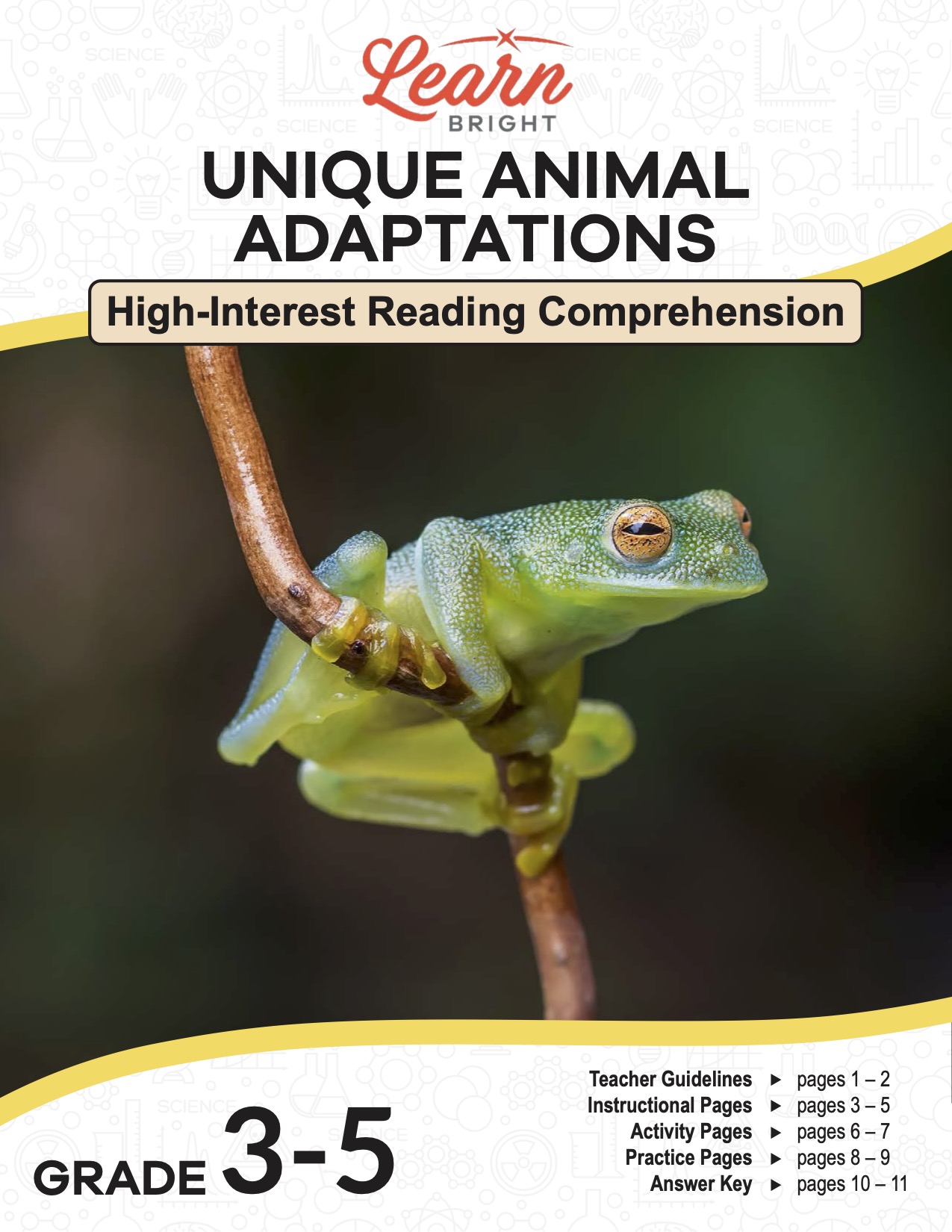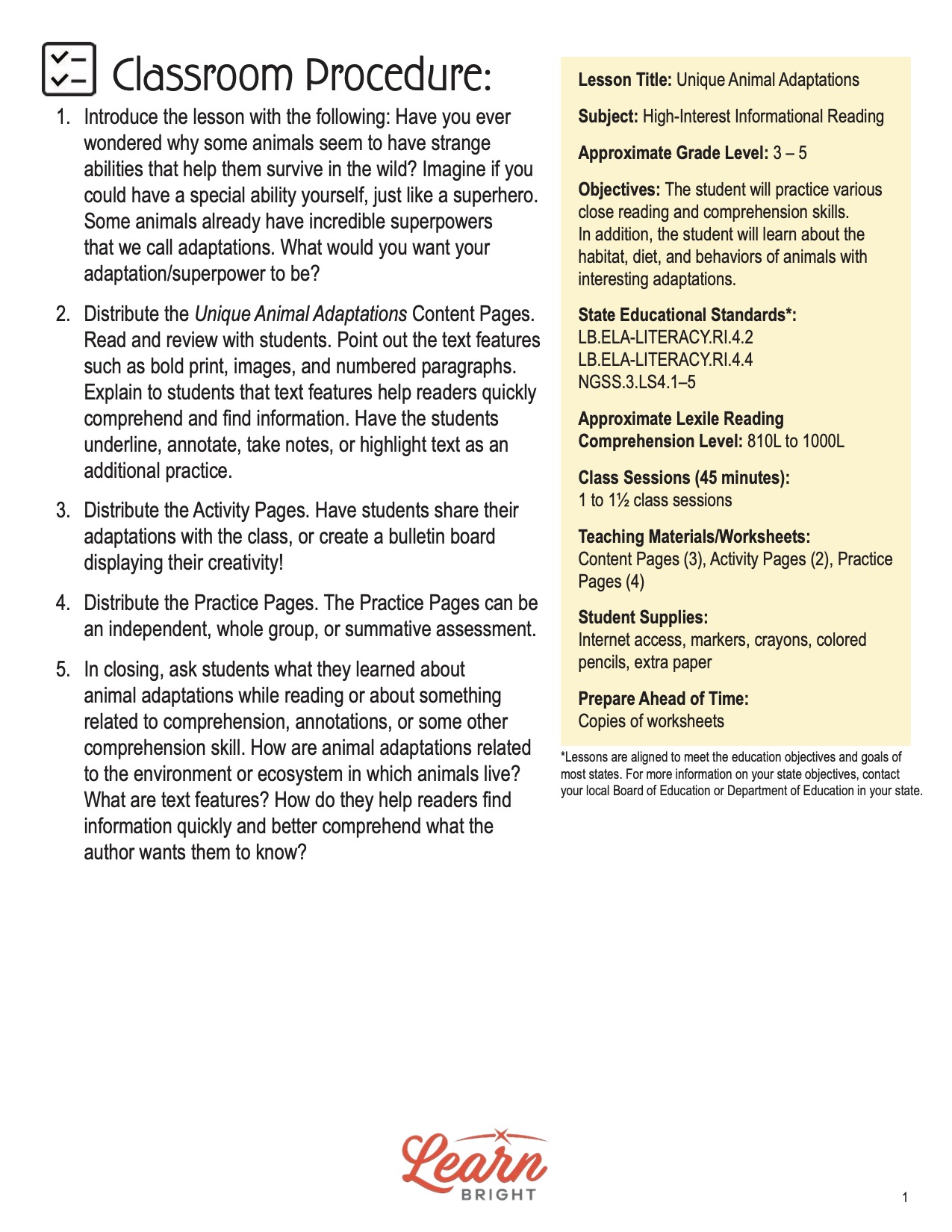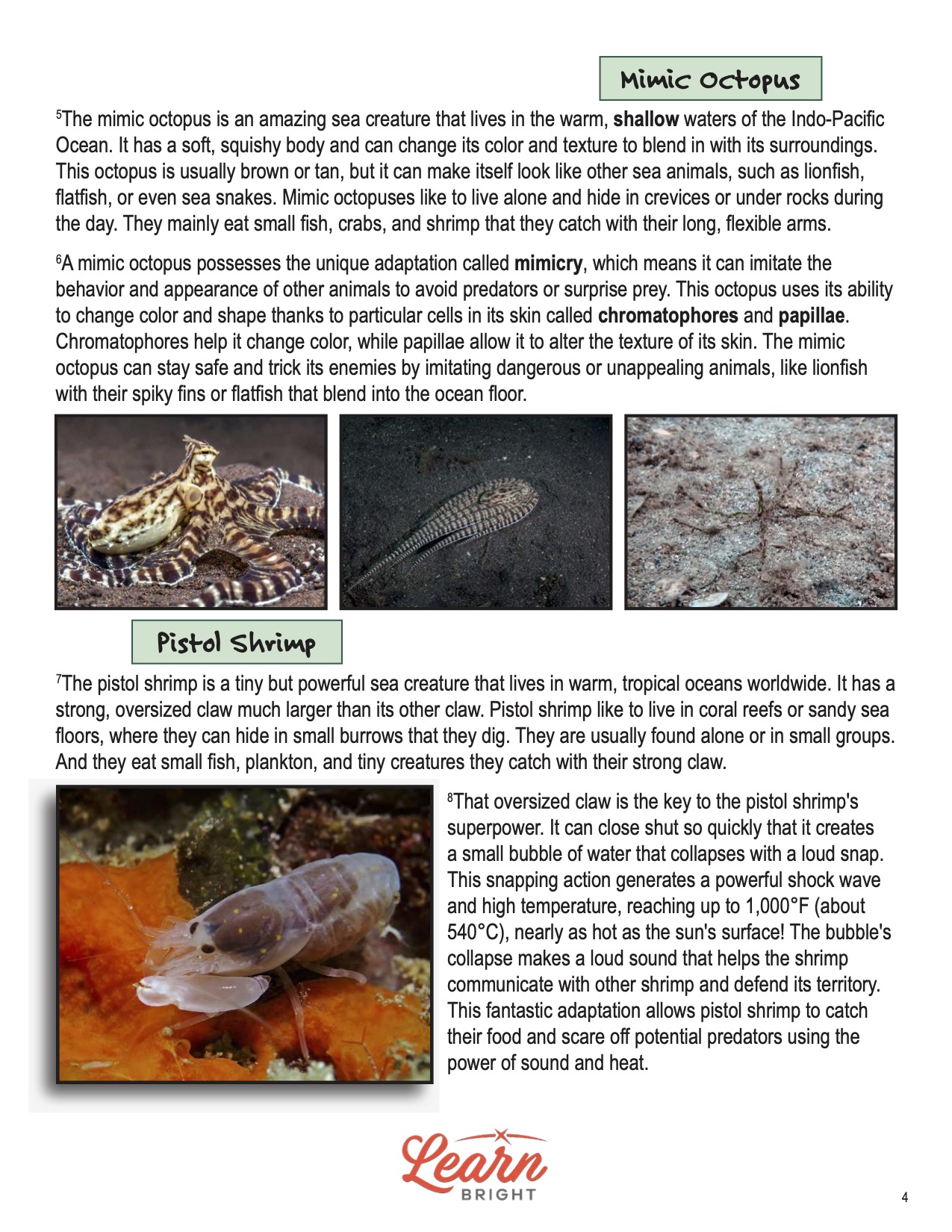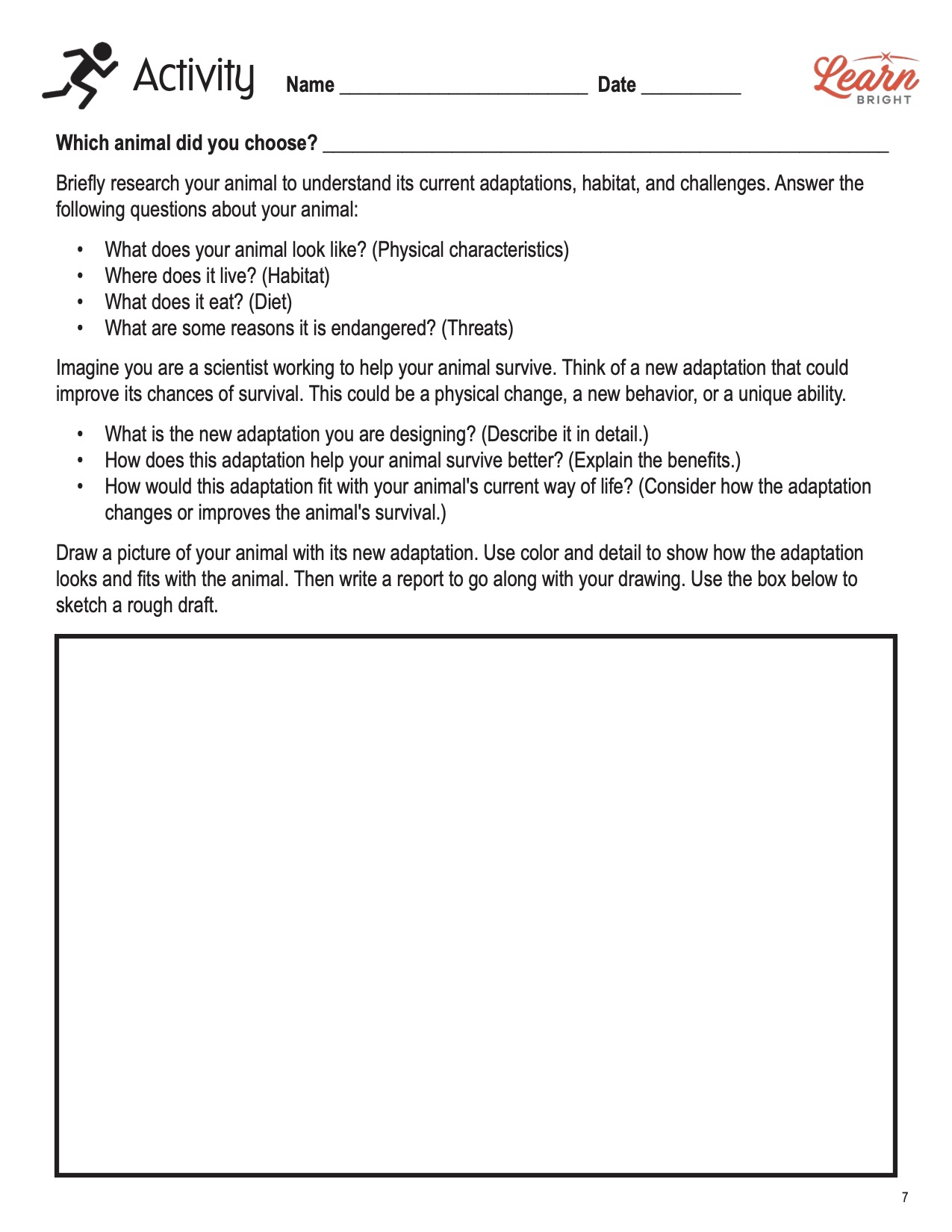Description
What our Unique Animal Adaptations lesson plan includes
Lesson Objectives and Overview: Unique Animal Adaptations is a high-interest reading comprehension lesson plan. As such, students will practice various close reading and comprehension skills. In addition, they will learn about the habitat, diet, and behaviors of animals with interesting adaptations. This lesson is for students in 3rd grade, 4th grade, and 5th grade.
Classroom Procedure
Every lesson plan provides you with a classroom procedure page that outlines a step-by-step guide to follow. You do not have to follow the guide exactly. The guide helps you organize the lesson and details when to hand out worksheets. It also lists information in the yellow box that you might find useful. You will find the lesson objectives, state standards, and number of class sessions the lesson should take to complete in this area. In addition, it describes the supplies you will need as well as what and how you need to prepare beforehand. Gather markers, crayons, colored pencils, and extra paper for the activity.
Teacher Notes
The teacher notes page provides an extra paragraph of information to help guide the lesson and remind you what to focus on. It explains that you can teach this lesson in a whole-class setting or as an independent, small-group activity. The blank lines on this page are available for you to write out thoughts and ideas you have as you prepare the lesson.
UNIQUE ANIMAL ADAPTATIONS LESSON PLAN CONTENT PAGES
Thorny Devil
The Unique Animal Adaptations lesson plan contains three content pages. It begins right off by talking about the thorny devil lizard. The thorny devil lizard is a cool-looking reptile that covered in sharp, thorny spikes all over its body. This helps protect it from predators because it seems too spiky to eat! It lives in Australia’s hot, dry deserts, where it can wander around in the sand and rocks. Thorny devils are solitary creatures, meaning they usually live alone rather than in groups. They mainly eat tiny ants, which they catch with their sticky tongue. These lizards are fairly small, about the size of a ruler, and have a unique look that helps them blend in with their surroundings.
Thorny devils have a unique adaptation called a pseudo head on the back of their necks. This false head appears to be a second head with fake eyes and spikes, which confuses predators and makes the lizard look even more intimidating. Additionally, the thorny devil has grooves on its skin that can channel rainwater directly to its mouth, allowing it to drink without finding a water source. This clever adaptation helps it survive in the dry desert by using every drop of moisture it can get!
Electric Eel
The electric eel is a fascinating fish that lives in the rivers of South America, such as the Amazon River. Even though it’s called an eel, it’s a type of knifefish. Electric eels are long and slim. Their bodies can grow up to eight feet long. They usually live alone in the murky river waters, hunting for food. Their diet generally includes small fish, amphibians, and even insects.
What unique feature makes them stand out? Electric eels can generate electric shocks! They have a unique adaptation that allows them to produce electric shocks using specialized cells called electrocytes. Those cells stack up in organs along the eel’s body, creating a powerful electric current when they work together. This current can be as strong as 600 volts, enough to stun or kill other fish and deter predators. The electric eel uses this ability to navigate dark waters, locate prey, and defend itself, making it a true marvel of nature!
Mimic Octopus
The mimic octopus is an amazing sea creature that lives in the warm, shallow waters of the Indo-Pacific Ocean. It has a soft, squishy body and can change its color and texture to blend in with its surroundings. This octopus is usually brown or tan, but it can make itself look like other sea animals, such as lionfish, flatfish, or even sea snakes. Mimic octopuses like to live alone and hide in crevices or under rocks during the day. They mainly eat small fish, crabs, and shrimp that they catch with their long, flexible arms.
A mimic octopus possesses the unique adaptation called mimicry, which means it can imitate the behavior and appearance of other animals to avoid predators or surprise prey. This octopus uses its ability to change color and shape thanks to particular cells in its skin called chromatophores and papillae. Chromatophores help it change color, while papillae allow it to alter the texture of its skin. The mimic octopus can stay safe and trick its enemies by imitating dangerous or unappealing animals, like lionfish with their spiky fins or flatfish that blend into the ocean floor.
Pistol Shrimp
The pistol shrimp is a tiny but powerful sea creature that lives in warm, tropical oceans worldwide. It has a strong, oversized claw much larger than its other claw. Pistol shrimp like to live in coral reefs or sandy sea floors, where they can hide in small burrows that they dig. They are usually found alone or in small groups. And they eat small fish, plankton, and tiny creatures they catch with their strong claw.
That oversized claw is the key to the pistol shrimp’s superpower. It can close shut so quickly that it creates a small bubble of water that collapses with a loud snap. This snapping action generates a powerful shock wave and high temperature, reaching up to 1,000°F (about 540°C), nearly as hot as the sun’s surface! The bubble’s collapse makes a loud sound that helps the shrimp communicate with other shrimp and defend its territory. This fantastic adaptation allows pistol shrimp to catch their food and scare off potential predators using the power of sound and heat.
Glass Frog
The glass frog is a little amphibian that lives in the rainforests of Central and South America. Its transparent belly lets you see its internal organs, like its heart and stomach. Glass frogs are tiny and have green or yellowish-green skin on their backs that helps them blend in with the leaves. They usually live alone or in small groups and spend their time on leaves and branches above streams. Glass frogs eat tiny insects like flies, mosquitoes, and ants that they catch with their long, sticky tongues.
Transparency is the glass frog’s unique adaptation, which means its belly is clear so you can see inside its body. Its skin has very few pigment cells, making it appear like glass. This transparency helps the frog stay safe by making it harder for predators to spot it against the bright green leaves and branches. Additionally, this unique feature allows researchers to study the frog’s organs and how they work without harming the frog, making the glass frog a valuable species for scientific study.
Unique Animal Adaptations
Although all species of animals and plants have adaptations, these animals have some of the more interesting abilities that help them survive. Some adaptations protect animals from harsh weather. Others help animals blend in to their surroundings to protect them from predators or to warn predators to stay away. And some allow animals to find food more easily or go for long periods of time without water. Can you think of any other animals that have unique adaptations?
UNIQUE ANIMAL ADAPTATIONS LESSON PLAN WORKSHEETS
The Unique Animal Adaptations lesson plan includes two worksheets: an activity worksheet and a practice worksheet. Each one will help students solidify their grasp of the material they learned throughout the lesson. You can refer to the classroom procedure guidelines to know when to hand out each worksheet.
NEW ADAPTATIONS ACTIVITY WORKSHEET
For the activity, students will review a list of endangered animals. They will choose one animal from the list and write it on the line at the top of the second activity page. Then they will follow the prompts to design and draw out the animal with a new adaptation that would help improve its chances of survival.
UNIQUE ANIMAL ADAPTATIONS PRACTICE WORKSHEET
The practice worksheet lists 10 questions based on the content. These questions all relate to the content pages, so students will need to refer to them often for the answers. In addition, each question provides which reading tool the question corresponds to, such as text feature, vocabulary, or comprehension.
Worksheet Answer Keys
At the end of the lesson plan document is an answer key for the practice worksheet. The correct answers are all in red to make it easier for you to compare them with students’ responses. If you choose to administer the lesson pages to your students via PDF, you will need to save a new file that omits these pages. Otherwise, you can simply print out the applicable pages and keep these as reference for yourself when grading assignments.









